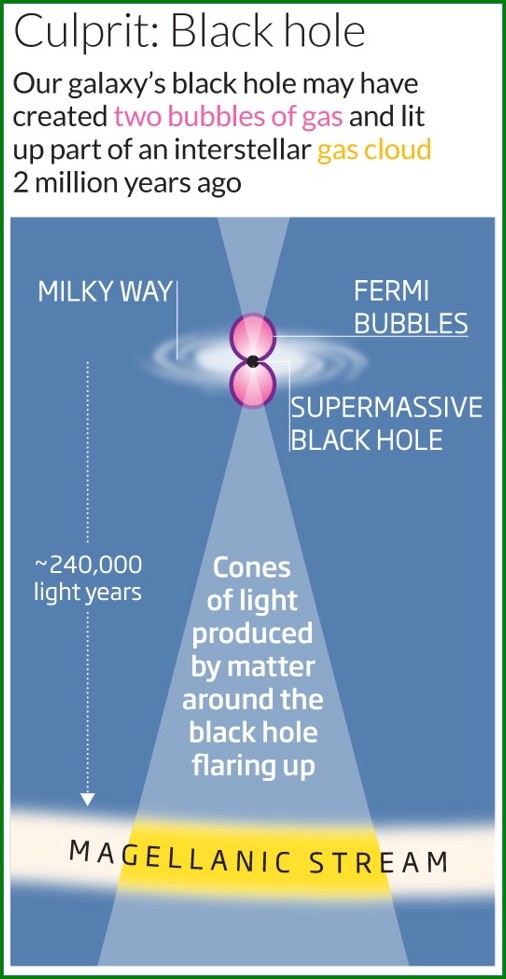If the nucleus of our Galaxy will become active again if the core of our Milky Way galaxy will become active again, systems and planets that close, it's hot not find it.
Scientists from the University of Sydney (Australia), led by Joss Bland-Hawthorne (Joss Bland-Hawthorn), argue that defined the time when a supermassive black hole (SMCHD) at the center of our galaxy is not hiding, and, like many other SMCHD, illuminated Milky Way, throwing bright relativistic jets of matter, accelerated to enormous speeds, up and down from the galactic disk.

Vicinity of the black hole Sagittarius A * eyes Very Large Telescope (illustration ESO, VLT).
Typically, the galaxy in which something like this happens to resemble a Christmas tree in a dull night: they can be seen from afar. It is active nuclei of galaxies were the first objects that humanity is found at a distance of billions of light years. Absorbing material, the black hole heats it to the point that it glows, and it emitted jets form along the length of a whopping huge glowing object brightness.
Several years ago, the results of observations of gamma-ray telescopes have indicated that up and down from the Galaxy have bubbles (sometimes referred to as Fermi bubbles on the name of their discoverer telescope), ending a 25-thousand light-years from the galactic disk.
Immediately after that, there was the theory that the bubbles - it traces the outbreak in the region of Sagittarius A *, accompanied by jets and the emission of matter, plasma, which is the current barely discernible boundaries of the bladder. But when did this happen? Flash duration, based on the experience of observations of other galaxies, more or less clear: to hundreds of thousands of years. With the date worse.
The situation is bad bladder wall prompter, astronomers have known that the ejection of matter from the surrounding area SMCHD can go with a completely different speeds.
Mr. Bland-Hawthorn, just hearing about bubbles, decided that such a flash in the past Sagittarius A * could remove another long-standing puzzle. In 1996, astronomers discovered that part of the Magellanic Stream (a fast-moving stream of hydrogen at 240 thousand light-years from the Milky Way, the entire disk which has a diameter of about 100 thousand light years) goes much stronger than the rest of the material of the object. Maybe it's in the bubbles Fermi?
After all, this is the brightest part is below the galactic center, it would have to be in front of the flash ...
After reviewing their interesting part of the Magellanic Stream, astronomers have decided that it is caused by an unusual glow intense ultraviolet radiation, which is part of the ionized gas flow. It is interesting that the experience of observing other galaxies with an active nucleus are known to emit very bright in the UV range.
By calculating the time in which ultraviolet light from the nucleus could reach the glowing part of the stream and ionize it, and how long the flood light then get to us, the scientists, as they feel able to very accurately date the event - the last severe outbreak in the region of Sagittarius A * .
So, it was relatively recently - about two million years ago. That is, all these Homo Habilis and even the first Homo Erectus, extinct 30 thousand years ago, it could see in the sky an unusual sight as an active galactic nucleus night light is not worse than the Moon:
The work is interesting not only because we are familiar with the details of the device during the night lighting Olduvai culture. The idea of some theorists that active galactic nuclei could arise only in mergers with another galaxy (due to the receipt of additional mass of dust and gas), and, therefore, the flash - a very rare event, pretty much called into question: does not seem to a couple of million years ago, the Milky Way merged with something ...

Far below the active core of the Milky Way a couple of million years ago was the Magellanic Stream, part of which is still glowing from the then-radiation from the vicinity of Sagittarius A *. (Illustration New Scientist.)
In contrast, recent ideas other theorists that flashes can occur as the cooling gas in the areas far from the galactic nucleus and its drift towards the center to give indirect.
Incidentally, all this also means that the core of our Galaxy can become active again, and at any time. Of course, for the inhabitants of nearby planets it will be a deadly spectacle, but in this case we were not in danger: We will protect a distance of a quarter of hundreds of thousands of light years. Another thing is that the concept of the so-called galactic habitable zone is filled with new meaning: if the cleaning of all living things in the nucleus of the galaxy do happen every few million years, the civilization there will be difficult.
With preprint considered work can be found here.
in the wake of NewScientist, Shutterstock, compulenta.computerra.ru
Samsung Galaxy S4 Active Sneak Peek
Here's a quick video peek from an informant at the Samsung Galaxy S4 Active Android smartphone. Not yet officially announced, the S4 Active comes to us via a source who got his hands on the device overseas (this is a leak, not a review). The S4 Active GT-19295 has a 1.9GHz quad core CPU according to Samsung (our reporter was initially told it had a dual core but thankfully that's not the case), an 8MP rear camera with all the features found on the standard Galaxy S4 and a dust-proof and waterproof design. The remaining specs are the same as the non-rugged GS4 like the 5" full HD display.
Watch our video review of the release Galaxy S4 Active: http://youtu.be/SUgmvFKp_Qs